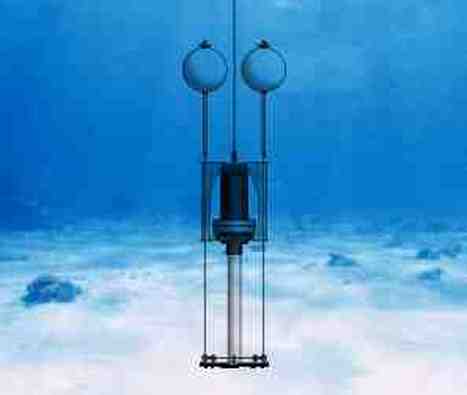
PVL's VC-3.5.2 Vibracore - How it works
The VC-3.5.2 vibracore uses an electric motor to drive a pair of masses that are eccentrically mounted on their respective shafts. These masses rotate about a common(horizontal) axis but in opposite directions, producing a rectilinear vibratory force vertically, and a vibratory torque about the vertical axis. The frequency of vibration ranges from approximately 8,000 RPM to 10,000 RPM. The actual vibrational displacement of the vibracore is only on the order of a few tens of thousandths of an inch, so essentially no mixing of the sediment within the tube occurs.
When a core tube is rigidly attached to the VC-3.5.2 power head, the vibrational energy is propagated along the tube and into the sediments. This vibrational energy tends to re-orient the soil particles at the lower end of the core tube, causing them to move out of the way of the advancing core tube and into a more efficient(i.e. denser) packing. Because the soil is saturated, the pore water pressure in the region around the core tube increases. As pore pressure increases, the effective confining stress in the soil decreases (according to the principle of effective stress), and the strength of the soil diminishes. With the penetration resistance(i.e. shear strength) of the soil thereby reduced, the core tube penetrates the soil under the static weight of the VC-3.5/core tube assembly. To provide additional penetration capability, clamp-on weights are available which utilize a vibration-isolation system to effectively increase the static driving force withwith minimal reduction in the vibrational energy transmitted to the sediments.
The VC 3.5.2 is designed to achieve a compromise between small vibrations, which produce limited penetration capability, and large vibrations, which can prove destructiveto the sample. While some densification of the material within the tube does occur,the stratigraphy can be maintained, which is important for establishing a timeline for sedimentation processes. It has also been designed to be light in weight and small in size, since much of the vibracoring work is in shallow areas, often where subsequent dredging will occur, and where small sampling rigs are used. Nevertheless, it has been used effectively in a variety of projects from Europe to the South Pacific,in both fresh and seawater, and at depths ranging from 1 to 150 meters. The vibracore has proven to be useful for gathering cores of more than 5 meters in length.
The core tubes are attached to the vibracore using a specially manufactured flange,which incorporates an integral check-valve. During extraction of the core from the sediments the check valve closes, producing suction within the core tube, which assists in retaining the core. Typical diameters range from 5 cm to 10 cm (2.0 inches to 4 inches).
The VC-3.5.2 vibracore uses an electric motor to drive a pair of masses that are eccentrically mounted on their respective shafts. These masses rotate about a common(horizontal) axis but in opposite directions, producing a rectilinear vibratory force vertically, and a vibratory torque about the vertical axis. The frequency of vibration ranges from approximately 8,000 RPM to 10,000 RPM. The actual vibrational displacement of the vibracore is only on the order of a few tens of thousandths of an inch, so essentially no mixing of the sediment within the tube occurs.
When a core tube is rigidly attached to the VC-3.5.2 power head, the vibrational energy is propagated along the tube and into the sediments. This vibrational energy tends to re-orient the soil particles at the lower end of the core tube, causing them to move out of the way of the advancing core tube and into a more efficient(i.e. denser) packing. Because the soil is saturated, the pore water pressure in the region around the core tube increases. As pore pressure increases, the effective confining stress in the soil decreases (according to the principle of effective stress), and the strength of the soil diminishes. With the penetration resistance(i.e. shear strength) of the soil thereby reduced, the core tube penetrates the soil under the static weight of the VC-3.5/core tube assembly. To provide additional penetration capability, clamp-on weights are available which utilize a vibration-isolation system to effectively increase the static driving force withwith minimal reduction in the vibrational energy transmitted to the sediments.
The VC 3.5.2 is designed to achieve a compromise between small vibrations, which produce limited penetration capability, and large vibrations, which can prove destructiveto the sample. While some densification of the material within the tube does occur,the stratigraphy can be maintained, which is important for establishing a timeline for sedimentation processes. It has also been designed to be light in weight and small in size, since much of the vibracoring work is in shallow areas, often where subsequent dredging will occur, and where small sampling rigs are used. Nevertheless, it has been used effectively in a variety of projects from Europe to the South Pacific,in both fresh and seawater, and at depths ranging from 1 to 150 meters. The vibracore has proven to be useful for gathering cores of more than 5 meters in length.
The core tubes are attached to the vibracore using a specially manufactured flange,which incorporates an integral check-valve. During extraction of the core from the sediments the check valve closes, producing suction within the core tube, which assists in retaining the core. Typical diameters range from 5 cm to 10 cm (2.0 inches to 4 inches).
